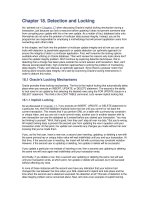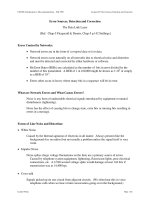Detection and Locking
Bạn đang xem bản rút gọn của tài liệu. Xem và tải ngay bản đầy đủ của tài liệu tại đây (28.39 KB, 7 trang )
Chapter 18. Detection and Locking
As I pointed out in Chapter 17 when discussing Oracle's implicit locking mechanism during a
transaction, just because you lock a resource before updating it does not prevent someone else
from corrupting your update with his or her own update. As a matter of fact, database locks unto
themselves do not solve the problem of multiuser data access integrity. Instead, you as the
programmer are responsible for employing a methodology that will prevent application users from
overwriting each other's data.
In this chapter, we'll look into the problem of multiuser update integrity and at how you can use
locks with detection (a pessimistic approach) or update detection (an optimistic approach) to
ensure the integrity of data in a multiuser application. First, we'll examine the locking options
available when utilizing an Oracle database. Then we'll review the reasons why locks alone don't
solve the update integrity problem. We'll continue by exploring detection techniques, that is,
detecting that a change has taken place outside the current session and transaction. Next, we'll
discuss several pessimistic, high-contention approaches to solving the problem of maintaining
data integrity. Finally, we'll discuss an optimistic approach. Since there's a popular notion that
locking alone ensures data integrity, let's start by examining Oracle's locking mechanisms in
order to debunk this notion.
18.1 Oracle's Locking Mechanisms
Oracle provides three locking mechanisms. The first is the implicit locking that automatically takes
place when you execute an INSERT, UPDATE, or DELETE statement. The second is the ability
to lock rows for an update by first selecting the desired rows using the FOR UPDATE clause in a
SELECT statement. The third is the LOCK TABLE command. Let's review implicit locking first.
18.1.1 Implicit Locking
As we discussed in Chapter 17, if you execute an INSERT, UPDATE, or DELETE statement for
a particular row, then the database implicitly locks that row until you commit or roll back the
current transaction. This means that if you perform DML on a table with a primary key constraint
or unique index, and you are not in auto-commit mode, another user in another session with its
own transaction can see the database as it existed before you started your transaction. You may
be thinking to yourself, "Well, that's good, then they can't step all over my data." But you're wrong.
All implicit locking does is prevent the second user from updating the row in question until your
transaction ends. At that point, her update can overwrite any changes you made without her ever
knowing that you've made them.
If you, as the first user, insert a new row, a second user inserting, updating, or deleting a row with
the same primary key or unique index value will wait indefinitely until you end your transaction. At
that time, if the second user is inserting, her insert will fail with a primary key constraint violation.
However, if the second user is updating or deleting, her update or delete will be successful.
If you update a particular row instead of inserting a row, then a second user updating or deleting
the same row will once again wait indefinitely until your transaction ends.
And finally, if you delete a row, then a second user updating or deleting the same row will wait
until your transaction ends, at which point, her update or delete will succeed, but it will succeed
without affecting any rows.
In none of these instances will the second user have any indication that your actions had
changed the row between the time when your SQL statement's implicit lock took place and the
time when the second user's statement executed. No detection at all! This lack of detection is the
data integrity problem we're concerned about. Now, let's look at an example of explicit locking.
18.1.2 Row Locking
Using Oracle's FOR UPDATE clause in a SELECT statement, you can prelock any desired rows
before updating them. The rows you lock with your SELECT statement will remain locked until
you end your transaction with a commit or rollback. For example, to lock all the rows in the person
table with a last name of "O'Reilly," use a SELECT statement such as the following:
select *
from person
where last name = 'O''Reilly'
for update;
Of course, using FOR UPDATE means you have an extra step to perform in your program; you'll
have to add a SELECT statement before each UPDATE or DELETE to explicitly lock the rows
you intend to affect. This will allow you to detect if another user has already locked the desired
rows by making your program wait to acquire the lock. However, this will still not solve the
integrity problem completely, because you won't see if rows you are about to INSERT have
already been inserted. In addition, your SELECT statement will wait indefinitely until it can acquire
a lock. So, for the FOR UPDATE clause to be useful as a means of detecting if another session
has a lock on something for which you wish to acquire a lock, you'll have to use it with the
NOWAIT modifier.
If you execute a SELECT statement with FOR UPDATE NOWAIT, and it can't acquire a lock
immediately, it will generate an SQLException with the Oracle error "ORA-00054: resource
busy and acquire with NOWAIT specified." You can then use the generation of this error to
control how you respond when a row you want is already locked by another session. Using
explicit locks to maintain update integrity requires a great deal of additional programming effort
and works only if every application that updates the database uses the technique. And that's
unlikely!
18.1.3 Table Locking
Now that you know how to explicitly lock rows, let's look at how to lock an entire table. Locking an
entire table is a very high-contention action. Regardless of locking mode, no other user on the
system will be able to modify the table until you end your transaction, so use this approach only
as a last resort. In 15 years of using Oracle and building applications, I have had only one
instance in which it was necessary to lock an entire table. The LOCK TABLE command syntax is:
lock table table_name in mode [nowait]
which breaks down as:
table_name
The name of the table you wish to lock
mode
One of five possible lock modes:
share
share update
exclusive
row share
row exclusive
nowait
An optionally specified modifier that makes the LOCK TABLE command return an error if
it cannot acquire the lock immediately
Although you can lock an entire table, another user can still queue an update that will wait until
your transaction is finished with no knowledge of the changes you are making while the table is
locked, and hence, no update detection. By now you must be coming to the realization that
locking alone does not ensure data integrity. But just in case you aren't fully convinced, let's take
a look at an example that proves my point.
18.1.4 Locks Alone Don't Solve the Problem
The easiest way to demonstrate that locks alone don't solve the data integrity problem is to open
two SQL*Plus sessions and issue some SQL statements to show how one user can overwrite
another user's updates. For this experiment, we'll use the TEST_TRANS table created in
Chapter 17. If that doesn't exist, and you want to follow along, you'll need to create it now.
Recall that TEST_TRANS has two columns: COL1, which is the table's primary key, and COL2.
Both are VARCHAR2 columns. Let's start our experiment by inserting a new row into
TEST_TRANS from session one:
SQL> insert into test_trans values ( '1', 'X' );
1 row created.
Then let's commit:
SQL> commit;
Commit complete.
Next, still from session one, let's update the row we just inserted:
SQL> update test_trans set col2 = 'Y' where col1 = '1';
1 row updated.
Now, from session two, let's select the row from TEST_TRANS where COL2 is equal to X:
SQL> select * from test_trans where col2 = 'X';
C C
- -
1 X
At this point, session two knows that the row with a primary key equal to 1 has a value of X. Let's
now say that session two wants the row to have a value of Z in COL2. Unbeknownst to session
two, however, the row no longer has a value of X in COL2. Session one has changed the value of
COL2 to Y, but session two can't see that change because session one has not committed the
change. As far as session two is concerned, the row has the value X. To change that value to Z,
session two executes the following UPDATE statement:
SQL> update test_trans set col2 = 'Z' where col1 = '1';
After issuing this statement, session two waits indefinitely until session one commits, thus
releasing its lock. So let's proceed by committing session one's transaction:
SQL> commit;
Commit complete.
Now session two's update succeeds, and session two also commits its changes:
1 row updated.
SQL> commit;
Commit complete.
If you requery the row from session one, you'll see that the value is not Y, which was just set in
session one, but is instead Z. While this value seems legitimate to session two, it's probably not
the result the session one user expected to see after having just changed the value to Y. What
went wrong? Session two had no opportunity to detect that the row with a value of 1 in COL1 and
a value of X in COL2 no longer had a value of X in COL2, because the original value of COL2
was not used in the WHERE clause of the UPDATE statement it issued to change the value to Z.
To solve this problem, we need to include the original value of COL2 in the WHERE clause as a
form of update detection.
18.2 Detection
Detection, in our current discussion, is the ability to detect if data you are about to modify has
changed since the point when you selected it to be updated. There are several tactics you can
employ for detection. Let me clarify that we are no longer discussing locking, but detection.
Detection is mutually exclusive of locking.
The first two detection tactics we will discuss are pessimistic. By pessimistic, I mean it is
assumed that a user in another session will most likely modify all the columns of a row of data
you just selected to be updated by your program. One pessimistic detection approach is to use an
updatestamp. As an alternative to using an updatestamp, you can compare all the columns of a
table, or attributes of an object, to their original values in the WHERE clause of any UPDATE
statement that you issue.
The third detection tactic is optimistic. It operates under the premise that a user in another
session is not likely to modify the same data that you intend to modify. It entails comparing only
modified columns or attributes in a WHERE clause.
Let's examine each tactic in detail, beginning with an updatestamp.
18.2.1 Using an Updatestamp
An updatestamp is a number column in a table or a number attribute in an object. The database
increments its value by 1 each time you modify a given row or object. That way, you can compare
the updatestamp you retrieved from the database to its current value to detect a modification of
the row or object by another session.
The benefit of using an updatestamp is that it makes formulating a WHERE clause for an
UPDATE statement fairly simple. Typically, you need to include only the primary key and the
updatestamp in the WHERE clause. The drawback is that you have to add code to your
application, or even to the database in the form of triggers, to increment the updatestamp every
time a row or object is updated.
Adding an updatestamp to a row or object also means that you have to add an additional column
or attribute to every table or object type you use in your database. If you find this to be
undesirable, you can use the second detection method, in which you compare all columns and
attributes of the table (or object) that you are updating to their original values in the WHERE
clause of your UPDATE statement.
An Updatestamp Versus a Timestamp
In databases other than Oracle, you might be able to add an additional
column or attribute of a timestamp data type and then have the database
update the timestamp every time a row or object is updated. Then, you
can compare the value of the timestamp in the database to the original
value you retrieved prior to your update in the SQL statement's WHERE
clause. However, this does not work with Oracle because Oracle's
timestamp data type, DATE, holds values only down to the second. In
addition, if you create a custom data type, such as a number, to hold the
time value down to milliseconds, you'll find that Oracle can still perform
several hundred updates within that time frame. So a feasible approach
is to use an updatestamp.
18.2.2 Comparing All Columns or Attributesto Their Original Values
A second detection tactic is to compare all the columns (or attributes) in the table (or object) that
you are updating to their original values. You do this as part of your UPDATE statement in the
WHERE clause; so the UPDATE statement fails if someone else has modified the row in
question. With reference to my earlier example, when session two retrieved the row in which
COL2 contained an X, it found that COL1 was equal to 1. To rewrite session two's UPDATE
statement to include detection, add a comparison of COL2 to its original value. For example:
update test_trans
set col2 = 'Z'
where col1 = '1' and col2 = 'X';
Execute this UPDATE statement from session two in the earlier example, and no rows will be
affected. The reason no rows will be affected is because COL2 has been modified by session one
and is no longer equal to X. You can use the fact that the executeUpdate( ) method returns 0
for the number of rows affected to determine that the update was not successful. You then know
that the row was changed between the time you selected it and the time you attempted your
update.
The benefit to using all columns or attributes in a WHERE clause is that you don't have to add an
additional updatestamp column or attribute to your tables and objects. The drawback is that you
have to formulate a more complex, and larger, WHERE clause. If a table has 20 columns, you
have to compare all 20 columns to their original values.
One problem with both pessimistic methods of detection is that they prevent more than one user
from updating a row in a table at any point in time without an update failure, in the sense that a
second updator will always fail. Accordingly, we call these low-concurrency methods. The fact
that they essentially check on an entire row or object is what makes them pessimistic.
18.2.3 Comparing Modified Columns or Attributes to Their Original Values
The third method, which provides a high level of concurrency, is to compare only modified
columns to their original values. To facilitate a high amount of concurrency, that is, the ability for
multiple users to update the same row or object without update failure, you can detect changes
that are relevant only to your UPDATE statement by including only the primary key and the
modified columns in the WHERE clause of the UPDATE statement. For example, let's use the
person table we created in Chapter 8. Let's assume that we insert a row:
insert into person (
person_id,
last_name,
first_name,
middle_name,
birth_date,
mothers_maiden_name )
values (
1,
'O''Reilly',









